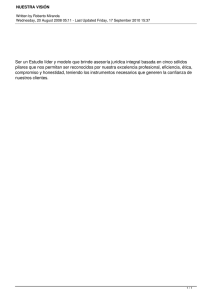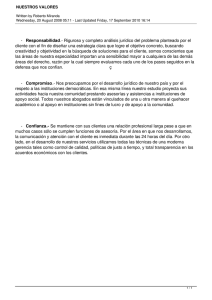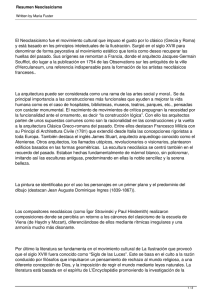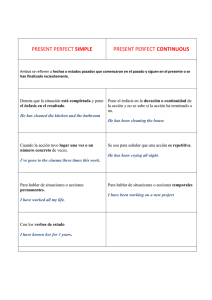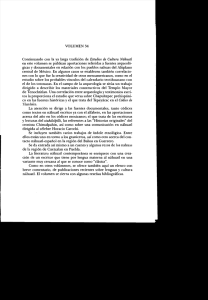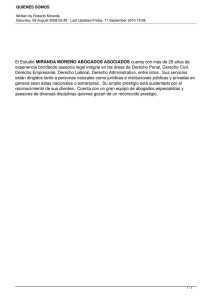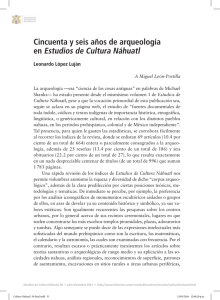Pistas ortográficas del náhuatl
Anuncio
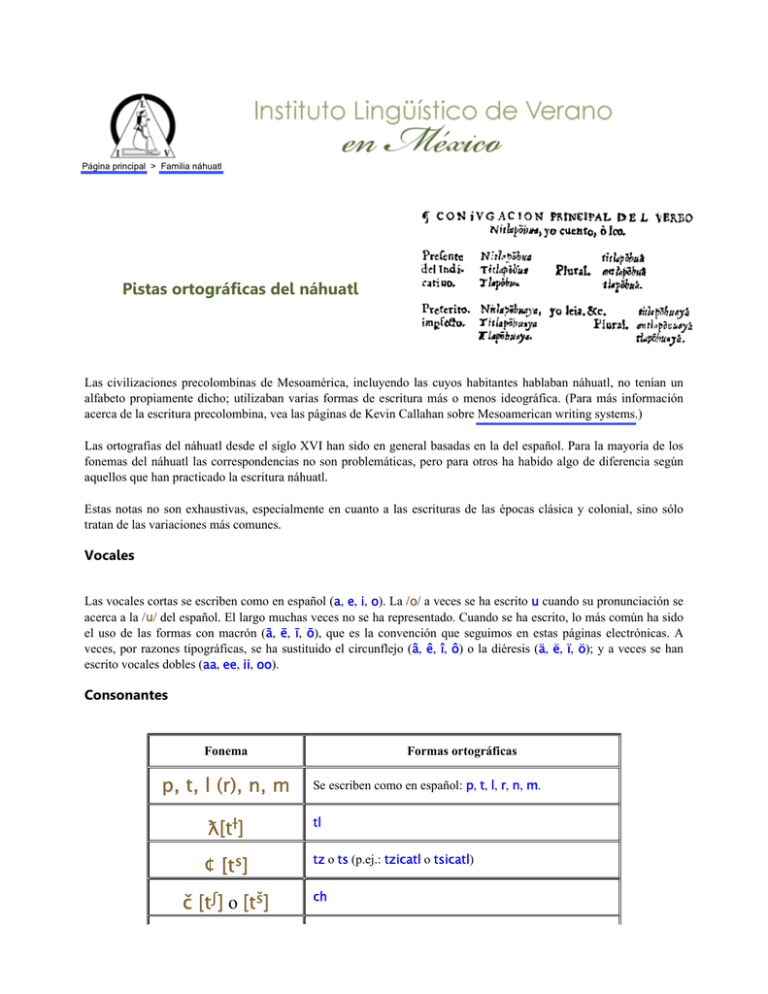
Página principal > Familia náhuatl Pistas ortográficas del náhuatl Las civilizaciones precolombinas de Mesoamérica, incluyendo las cuyos habitantes hablaban náhuatl, no tenían un alfabeto propiamente dicho; utilizaban varias formas de escritura más o menos ideográfica. (Para más información acerca de la escritura precolombina, vea las páginas de Kevin Callahan sobre Mesoamerican writing systems.) Las ortografías del náhuatl desde el siglo XVI han sido en general basadas en la del español. Para la mayoría de los fonemas del náhuatl las correspondencias no son problemáticas, pero para otros ha habido algo de diferencia según aquellos que han practicado la escritura náhuatl. Estas notas no son exhaustivas, especialmente en cuanto a las escrituras de las épocas clásica y colonial, sino sólo tratan de las variaciones más comunes. Vocales Las vocales cortas se escriben como en español (a, e, i, o). La /o/ a veces se ha escrito u cuando su pronunciación se acerca a la /u/ del español. El largo muchas veces no se ha representado. Cuando se ha escrito, lo más común ha sido el uso de las formas con macrón (ā, ē, ī, ō), que es la convención que seguimos en estas páginas electrónicas. A veces, por razones tipográficas, se ha sustituido el circunflejo (â, ê, î, ô) o la diéresis (ä, ë, ï, ö); y a veces se han escrito vocales dobles (aa, ee, ii, oo). Consonantes Fonema p, t, l (r), n, m ƛ[tƚ] ¢ [ts] č [tʃ] o [tš] Formas ortográficas Se escriben como en español: p, t, l, r, n, m. tl tz o ts (p.ej.: tzicatl o tsicatl) ch šoʃ x s s, z, ç; y cuando precede a una vocal anterior, c (p.ej.: se, ze, çe, ce representan /se/) k c cuando precede a una vocal posterior o a una consonante, y qu cuando precede a una vocal anterior (p.ej.: can y quen son /kan/ y /ken/), o k en todos los casos. kw cu (o a veces qu cuando precede a una vocal posterior), cuh (o a veces uhc) en posición final en la sílaba; o ku; o kw. Nótese que cuh no es sílaba. Por eso, aunque es común la pronunciación errónea, tecuhtli 'señor' tiene sólo dos sílabas CVC.CV /tekw.tƚi/. y y (o, a veces, i) w hu (en posición inicial en la sílaba) y uh (en posición final en la sílaba) (p.ej.: Huauhtla es /wawtla/). O bien, w en todos los casos, o u en todos los casos. También suele escribirse b o v cuando es labial. También se escribe o en documentos y nombres antiguos. (Por ejemplo, Oaxaca es /waxakan/.) ʔo h ("saltillo") No se escribe, o se escribe h, j, ', o con el acento grave (p.ej.: à es /aʔ/). Muchas variantes del náhuatl permiten una secuencia de /l/ + /l/, que naturalmente se escribe ll, y que aparece en palabras como calli 'casa' o tlaxcalli 'tortilla'. Este sonido no debe confundirse con la ll de la ortografía española, que en México generalmente se pronuncia [y]; es exactamente el mismo sonido de /l/, pero prolongado por más tiempo. En algunas variantes se ha perdido el largo de la [ll], y se pronuncia y se escribe l: e.g. cali 'casa' y tlaxcali 'tortilla'. En otras variantes se ha vuelto [hl] (ortográficamente jl) e.g. cajli 'casa' y tlaxcajli 'tortilla'. --David Tuggy T. La ilustración al principio de esta página es una porción facsimilar del Arte de la lengua mexicana de Horacio Carochi (1645). Notes on Nahuatl orthography The pre-Columbian Mesoamerican civilizations, including the Nahuatl-speaking ones, did not have an alphabet, properly speaking; they used different kinds of more-or-less ideographic writing. (For further information about preColumbian writing see Kevin Callahan's web pages on Mesoamerican writing systems.) The Nahuatl orthographies developed in the sixteenth century and since then have, naturally enough, usually been based on the Spanish writing system. For the majority of the Nahuatl phonemes, the correspondences were unproblematic, but for others there have been differing customs among those who have written Nahuatl. These notes are by no means exhaustive, especially in regard to the writings of classical and colonial times; they only deal with some of the more common variations. Vowels The short vowels have always been written as in Spanish (a, e, i, o). The vowel /o/ is sometimes written u when its pronunciation approaches that of Spanish /u/. Length has typically gone unrepresented. When it has been written, the most common convention has probably been the use of the macron (ā, ē, ī, ō). We follow that convention in these electronic pages. Sometimes, for typographical reasons, the circumflex (â, ê, î, ô) or the dieresis (ä, ë, ï, ö) has been used instead, and sometimes double vowels have been written (aa, ee, ii, oo). Consonants Phoneme Orthographic Forms p, t, l (r), n, m Written as in Spanish (and English); p, t, l, r, n, m. ƛ[tƚ] tl ¢[ts] tz or ts (e.g.: tzicatl or tsicatl) č[tʃ] or [tš] ch š x s s, z, ç; and, when preceding a front vowel, c (e.g.: se, ze, çe, ce represent /se/) k kw c when preceding a back vowel or a consonant, and qu when preceding a front vowel (e.g.: can and quen are /kan/ and /ken/), or k in all cases. cu (or qu when preceding a back vowel), cuh (or uhc) in syllable final position; or ku; or kw. Note that cuh is not a syllable. Accordingly, although an incorrect trisyllabic pronunciation is common, tecuhtli 'lord' has only two syllables CVC.CV /tekw.tƚi/. y y (sometimes i) w hu (in syllable initial position) and uh (in syllable final position) (e.g.: Huauhtla is /wawtla/). Or, w in all cases, or u in all cases. Also written as b or v when labial. Also written as o in older documents and names. (For example, Oaxaca is /waxakan/.) ʔ or h ("saltillo") Not written, or written as h, j, ', or a grave accent mark (e.g.: à is /aʔ/). A number of Nahuatl languages permit a sequence of /l/ + /l/, which, naturally enough, is written ll. It appears in words such as calli 'house' or tlaxcalli 'tortilla'. This is not at all like the Spanish ll, which in Mexico is generally pronounced [y]; rather it is a long /l/ sound. In some varieties of Nahuatl the length of this [ll] has been lost, and it is pronounced and written as l: e.g. cali 'house' and tlaxcali 'tortilla'. In other varieties it is pronounced [hl] (and typically written jl) e.g. cajli 'house' and tlaxcajli 'tortilla'. --David Tuggy The graphic at the top of this page is a facsimile of a portion of Horacio Carochi's 1645 Arte de la lengua mexicana. © 2008 Instituto Lingüístico de Verano, A.C. Derechos reservados. Puede reproducirse para fines no lucrativos siempre y cuando no se altere en forma alguna. All rights reserved. May be reproduced for nonprofit use so long as it is not modified in any way.
